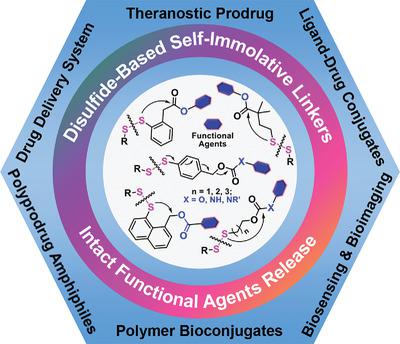当前位置:
X-MOL 学术
›
Macromol. Rapid Commun.
›
论文详情
Our official English website, www.x-mol.net, welcomes your
feedback! (Note: you will need to create a separate account there.)
Disulfide-Based Self-Immolative Linkers and Functional Bioconjugates for Biological Applications.
Macromolecular Rapid Communications ( IF 4.2 ) Pub Date : 2019-11-22 , DOI: 10.1002/marc.201900531 Zhengyu Deng 1 , Jinming Hu 1 , Shiyong Liu 1
Macromolecular Rapid Communications ( IF 4.2 ) Pub Date : 2019-11-22 , DOI: 10.1002/marc.201900531 Zhengyu Deng 1 , Jinming Hu 1 , Shiyong Liu 1
Affiliation

|
It is of vital importance to reversibly mask and selectively activate bioactive agents for advanced therapeutic and diagnostic purposes, aiming to efficiently suppress background interferences and attenuate systemic toxicity. This strategy has been involved in diverse applications spanning from chemical/biological sensors and diagnostics to drug delivery nanocarriers. Among these, redox-responsive disulfide linkages have been extensively utilized by taking advantage of extracellular and intracellular glutathione (GSH) gradients. However, direct conjugation of cleavable triggers to bioactive agents through disulfide bonds suffers from bulky steric hindrance and limited choice of trigger-drug combinations. Fortunately, the emergence of disulfide self-immolative linkers (DSILs) provides a general and robust strategy to not only mask various bioactive agents through the formation of dynamic disulfide linkages but also make it possible to be selectively activated upon disulfide cleavage in the reductive cytoplasmic milieu. In this review, recent developments in DSILs are focused with special attention on emerging chemical design strategies and functional applications in the biomedical field.
中文翻译:

用于生物应用的基于二硫键的自消灭性接头和功能性生物缀合物。
为了有效地抑制背景干扰并减轻全身毒性,可逆地掩盖和选择性激活生物活性剂对于先进的治疗和诊断至关重要。该策略已涉及从化学/生物传感器和诊断到药物输送纳米载体的各种应用。其中,通过利用细胞外和细胞内谷胱甘肽(GSH)梯度,氧化还原反应性二硫键已得到广泛利用。然而,通过二硫键将可裂解的引发剂直接缀合到生物活性剂上的方法是体积大的位阻和引发剂-药物组合的选择受限。幸运的是,二硫键自消灭性接头(DSIL)的出现提供了一种通用而强大的策略,不仅可以通过形成动态的二硫键来掩盖各种生物活性剂,而且还可以在还原性胞质环境中被二硫键裂解后选择性激活。在这篇综述中,DSIL的最新发展特别关注了在生物医学领域新兴的化学设计策略和功能应用。
更新日期:2019-11-22
中文翻译:

用于生物应用的基于二硫键的自消灭性接头和功能性生物缀合物。
为了有效地抑制背景干扰并减轻全身毒性,可逆地掩盖和选择性激活生物活性剂对于先进的治疗和诊断至关重要。该策略已涉及从化学/生物传感器和诊断到药物输送纳米载体的各种应用。其中,通过利用细胞外和细胞内谷胱甘肽(GSH)梯度,氧化还原反应性二硫键已得到广泛利用。然而,通过二硫键将可裂解的引发剂直接缀合到生物活性剂上的方法是体积大的位阻和引发剂-药物组合的选择受限。幸运的是,二硫键自消灭性接头(DSIL)的出现提供了一种通用而强大的策略,不仅可以通过形成动态的二硫键来掩盖各种生物活性剂,而且还可以在还原性胞质环境中被二硫键裂解后选择性激活。在这篇综述中,DSIL的最新发展特别关注了在生物医学领域新兴的化学设计策略和功能应用。











































 京公网安备 11010802027423号
京公网安备 11010802027423号